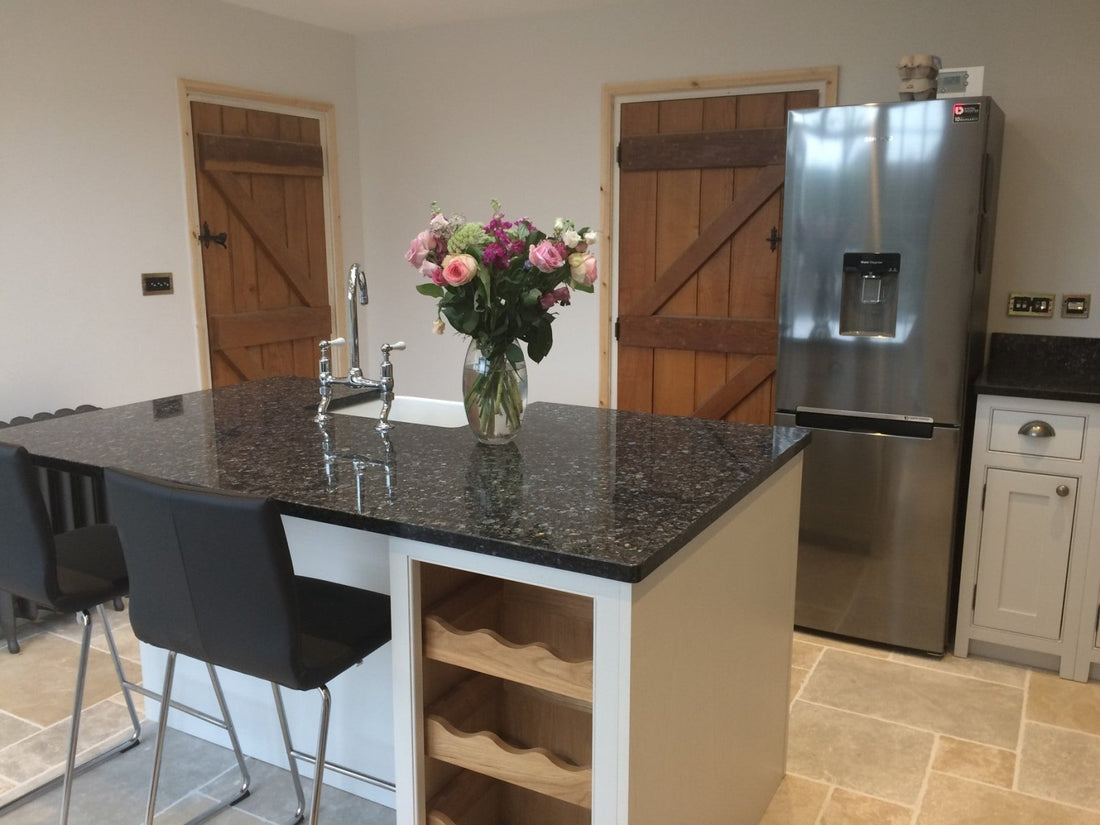
Behind the Scenes: The Process of Creating a Bespoke Painted Kitchen
Share
Designing a bespoke painted kitchen is more than just picking colours and cabinetry. It’s a journey — from initial consultation through to the final installation — where craftsmanship, creativity, and attention to detail come together to create a one-of-a-kind space tailored to your lifestyle and tastes. In this blog, we’ll take you behind the scenes, walking you through the entire process of creating a bespoke painted kitchen, from concept to completion.
1. Initial Consultation: Defining Your Vision
The journey begins with the initial consultation, where the focus is on understanding your vision for the kitchen. This meeting is an essential first step in creating a bespoke design that reflects your personality, lifestyle, and practical needs. Whether you're after a modern minimalist look or a timeless farmhouse style, the consultation phase is where the blueprint of your dream kitchen starts to take shape.
What Happens in the Consultation:
- Understanding Your Needs: The design team will ask questions about how you use your kitchen, the space available, and any specific requirements you have, such as extra storage, integrated appliances, or a large island for entertaining.
- Exploring Your Style: You’ll discuss your preferred design style, colour palette, materials, and any features or trends you want to incorporate. You might also review inspiration boards, sample kitchens, or portfolio images to hone in on your design preferences.
- Space Evaluation: A professional designer will take measurements and assess the space. If a remodel or renovation is part of the project, structural elements, plumbing, and electrical systems will also be evaluated at this stage.
By the end of this phase, you’ll have a clear vision of what your bespoke kitchen will look like, with a design team ready to bring it to life.
2. Design & Planning: Turning Ideas into Reality
Once the consultation phase is complete, the next step is turning ideas into a concrete plan. This stage involves detailed design work, including 3D renderings, material selection, and layout planning. Every aspect of the kitchen, from cabinetry to lighting, is tailored to fit your unique space and style.
Key Elements of the Design Phase:
- Creating a Layout: The kitchen layout is a crucial element of design, ensuring that the space is both functional and aesthetically pleasing. Designers will work to optimize your layout based on your specific requirements — be it a galley kitchen, an open-plan space, or a traditional U-shaped layout.
- Cabinetry Customization: One of the hallmarks of a bespoke kitchen is fully customized cabinetry. You’ll work with the design team to choose materials, colours, and styles, whether you prefer Shaker-style cabinets, sleek flat-panel designs, or something more ornate.
- Material and Finish Selection: This phase also includes selecting high-quality materials for worktops, backsplashes, hardware, and of course, the paint. Every detail is considered to ensure the materials align with your design vision, while also being durable and practical.
- 3D Visualization: To help you visualize the final result, many bespoke kitchen companies create detailed 3D renderings. This allows you to see how the cabinetry, colours, and layout will look in your space, and make adjustments before the work begins.
Once the design is approved, the kitchen moves into the production phase, where skilled artisans take over.
3. Handcrafting the Kitchen: The Art of Cabinetmaking
At the heart of any bespoke kitchen is craftsmanship. Every piece of cabinetry and furniture is handcrafted to exact specifications, ensuring the perfect fit and finish. Unlike mass-produced kitchens, bespoke cabinetry is often handmade by experienced carpenters who take pride in every detail of their work.
Steps in the Handcrafting Process:
- Cutting and Shaping: The first step in building your kitchen is cutting the high-quality wood to the precise measurements outlined in the design. This wood can range from oak and maple to more exotic species, depending on your preferences.
- Joinery and Assembly: Skilled craftsmen use traditional joinery techniques — such as dovetail joints and mortise-and-tenon connections — to build cabinetry that is both strong and aesthetically refined. This handmade approach ensures that every piece is built to last.
- Sanding and Finishing: Once assembled, the cabinets are carefully sanded to a smooth finish. This meticulous sanding process ensures that the wood is ready to receive the paint or stain that will define the final look.
This phase is all about precision and quality, and it’s where the uniqueness of your bespoke kitchen truly starts to shine.
4. The Painting Process: Achieving a Flawless Finish
One of the standout features of a bespoke painted kitchen is the flawless, hand-painted finish. Unlike factory-finished cabinets, which may have a uniform but impersonal look, hand-painting allows for a richer texture and depth, ensuring your kitchen feels unique.
The Steps to a Perfect Painted Kitchen:
- Primer Application: Before any colour is applied, the cabinetry is coated with a high-quality primer. This ensures that the paint adheres properly and that the final finish is smooth and durable.
- Multiple Paint Layers: Most bespoke kitchens require several coats of paint to achieve a deep, even colour. Each layer is applied carefully by hand, allowing for greater control over the finish and ensuring that brushstrokes are invisible.
- Custom Colour Matching: Bespoke painted kitchens often use custom-mixed colours, tailored to your preferences. Whether you want a classic white, a trendy sage green, or something completely unique, the design team will work with you to find the perfect shade.
- Protective Finish: Once the paint has dried, a protective finish is applied to ensure the cabinetry is resistant to everyday wear and tear, such as moisture, heat, and spills. This step guarantees that your kitchen will maintain its stunning appearance for years to come.
The hand-painted finish gives your kitchen a personal touch and elevates the overall quality of the space, making it distinct from mass-produced options.
5. Installation: Bringing the Vision to Life
Once the cabinetry has been handcrafted and painted, it’s time for the installation. This final phase is where all the individual pieces come together to transform your kitchen space. Experienced installers carefully fit every cabinet, countertop, and appliance into place, ensuring that everything is perfectly aligned and functional.
What Happens During Installation:
- Cabinetry Installation: The custom cabinetry is installed first, ensuring that it fits seamlessly within the space. Precise measurements taken earlier in the process ensure a perfect fit, even in rooms with uneven walls or non-standard layouts.
- Countertops and Appliances: Once the cabinetry is in place, the countertops, sinks, and appliances are installed. Whether you’ve opted for granite, quartz, or marble countertops, the installers ensure that everything fits perfectly and functions as expected.
- Final Touches: The last step in the installation process is adding the finishing touches — from hardware to light fixtures and any bespoke detailing. At this stage, the kitchen is given a final inspection to ensure that everything meets the highest standards of craftsmanship.
After the installation is complete, you’re left with a beautifully handcrafted, bespoke kitchen that is tailored to your style, functional needs, and space.
6. Aftercare: Ensuring Long-Lasting Quality
A bespoke kitchen is an investment, and like any investment, it requires proper care to ensure that it lasts for years to come. Most bespoke kitchen companies offer aftercare services, providing tips and guidance on how to maintain your kitchen.
Aftercare Services May Include:
- Touch-Up Paint Kits: Since hand-painted kitchens can be touched up by hand, many companies provide custom paint kits to help you maintain the flawless finish.
- Maintenance Tips: Proper care for cabinetry, countertops, and appliances is essential. You’ll receive detailed instructions on how to clean and maintain the materials used in your kitchen to keep them looking their best.
- Warranty and Support: Many bespoke kitchen companies offer warranties on craftsmanship and materials, ensuring that any issues are addressed promptly.
With the right care, your bespoke kitchen will remain beautiful and functional for decades, offering timeless elegance and exceptional quality.
Summary: The Journey of Crafting a Bespoke Painted Kitchen
Creating a bespoke painted kitchen is a deeply personal and rewarding experience. From the initial consultation to the final installation, every detail is considered and tailored to your specific needs and tastes. This hands-on approach ensures that your kitchen isn’t just another room in your house — it’s a reflection of your style, built with craftsmanship and care. Whether you’re designing a space for entertaining, family gatherings, or everyday use, a bespoke painted kitchen is an investment in quality and beauty that will stand the test of time.
